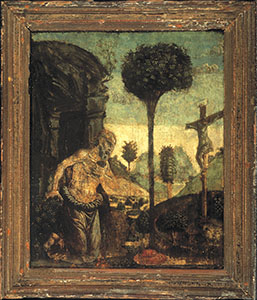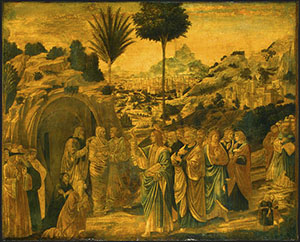
Saint Jerome the Penitent, Bardini Museum, Florence.

Resurrection of Lazarus, National Gallery of Art, Washington.
In 1494, following Piero di Lorenzo de’ Medici’s exile from Florence, Pisa, too, was caught up in the political struggles against the Florentine domain, resulting in expulsion of the Florentines residing in the city and confiscation of their property. However, despite being a Florentine, Benozzo was granted a placet by the Pisans and continued to reside in the city until 1495, evidence of the painter's desire to continue living in Pisa and confirmation of the high regard in which the city’s institutions held him.
His return to Florence took place during one of the great ideological changes that affected that city, from the above-mentioned exile of the Medici to the public preaching of Savonarola Friar who, over time, thanks to his dialectic and oratory abilities, became a moral, religious and political leader at a time when the public situation was descending into crisis. Benozzo had come into contact with the doctrine of the reformed mendicant orders (the Augustinians, Dominicans and Franciscans) on several occasions, and his final works, produced at an advanced age, demonstrated a profound adhesion to a strict and heartfelt spirituality wholly aligned with Savonarola’s preachings.
These personal meditations are clearly visible in his last works, such as the panel painting of Saint Jerome the Penitent, now housed in the Bardini Museum in Florence, and his two oil paintings for Bishop Pandolfini of Pistoia: the Deposition, now at the Horne Museum in Florence, and the Resurrection of Lazarus, in the National Gallery in Washington. These two works confirm that Benozzo, "master of wall-painting" and creator of numerous panel paintings, was also familiar with the new techniques of the time. They were painted when the aged artist was in Pistoia, where he moved in 1497 to carry out the prestigious commission of decorating an entire wall of the Council Chamber of the Town Hall. However, on 4th October that year, Benozzo Gozzoli passed away, leaving this final work - the fresco of the Virgin in majesty with angels and s
aints - at the sinopia painting stage.
His move to Pistoia once again demonstrated his renown as an "excellent master of wall-painting" and the prestige he had come to enjoy throughout Italy.
He was buried at the Church of San Domenico (Saint Dominic) in Pistoia and not in the Camposanto (Graveyard) in Pisa, as Vasari believed. The epigraph recalled by the biographer in his Lives is, in fact, the memorial tablet which, long before his death, the Pisans had given the artist in the Camposanto (graveyard) in commemoration and recognition of the frescoes he had painted there.
Serena Nocentini